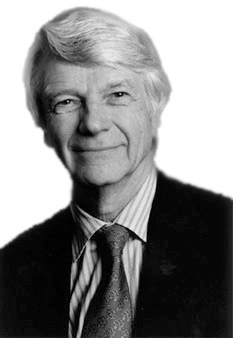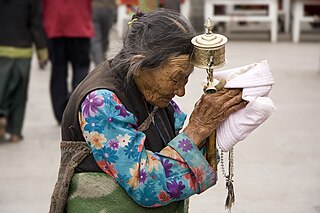Related Research Articles

Ilya Ilyich Mechnikov, also spelled Élie Metchnikoff, was a Russian zoologist best known for his pioneering research in immunology. He and Paul Ehrlich were jointly awarded the 1908 Nobel Prize in Physiology or Medicine "in recognition of their work on immunity".

Gerontology is the study of the social, cultural, psychological, cognitive, and biological aspects of aging. The word was coined by Ilya Ilyich Mechnikov in 1903, from the Greek γέρων, geron, "old man" and -λογία, -logia, "study of". The field is distinguished from geriatrics, which is the branch of medicine that specializes in the treatment of existing disease in older adults. Gerontologists include researchers and practitioners in the fields of biology, nursing, medicine, criminology, dentistry, social work, physical and occupational therapy, psychology, psychiatry, sociology, economics, political science, architecture, geography, pharmacy, public health, housing, and anthropology.

Robert Neil Butler was an American physician, gerontologist, psychiatrist, and author, who was the first director of the National Institute on Aging. Butler is known for his work on the social needs and the rights of the elderly and for his research on healthy aging and the dementias.
The Gerontological Society of America (GSA) is a multidisciplinary organization devoted to research and education in all aspects of gerontology: medical, biological, psychological and social.
Eileen M. Crimmins is the AARP Chair in Gerontology at the USC Davis School of Gerontology of the University of Southern California. Her work focuses on the connections between socioeconomic factors and life expectancy and other health outcomes.
Financial gerontology is a multidisciplinary field of study encompassing both academic and professional education, that integrates research on aging and human development with the concerns of finance and business. Following from its roots in social gerontology, Financial gerontology is not simply the study of old people but emphasizes the multiple processes of aging. In particular, research and teaching in financial gerontology draws upon four kinds of aging or "'four lenses" through which aging and finance can be viewed: population aging, individual aging, family aging, and generational aging. While it is problematic that "demography is destiny," demographic concepts, issues, and data play a substantial role in understanding the dynamics of financial gerontology. For example, through the lens of population aging, demography identifies the number of persons of different ages in cities and countries—and at multiple points in time. Through the lens of individual aging, demography also notes changes in the length of time—number of years lived in older age, typically measured by increases in life expectancy. From in its founding years in the beginning of the 21st century, one primary interest of Financial Gerontology has been on baby boomers and their relationships with their parents. The impact of these two kinds of aging on finance are reasonably apparent. The large and increasing number of older persons [population aging] in a society, no matter how "old age" is defined, and the longer each of these persons lives [individual aging], the greater the impact on a society's pattern of retirement, public and private pension systems, health, health care, and the personal and societal financing of health care. The focus on boomers illustrates also the other two lenses or "kinds" of aging. How boomers deal with the social, emotional, and financial aspects of their parents' aging is a central aspect of family aging. And how boomers may differ from their parents born and raised twenty to forty years earlier, and differ from their Generation X and Millennial children and grandchildren, are substantial aspects of generational aging.

The continuity theory of normal aging states that older adults will usually maintain the same activities, behaviors, relationships as they did in their earlier years of life. According to this theory, older adults try to maintain this continuity of lifestyle by adapting strategies that are connected to their past experiences.
Ewald William Busse was an American psychiatrist, gerontologist, author and academic administrator best known for being the dean of the Duke University School of Medicine.

The activity theory, also known as the implicit theory of aging, normal theory of aging, and lay theory of aging, proposes that successful aging occurs when older adults stay active and maintain social interactions. It takes the view that the aging process is delayed and the quality of life is enhanced when old people remain socially active. The activity theory rose in opposing response to the disengagement theory. The activity theory and the disengagement theory were the two major theories that outlined successful aging in the early 1960s. The theory was developed by Robert J. Havighurst in 1961. In 1964, Bernice Neugarten asserted that satisfaction in old age depended on active maintenance of personal relationships and endeavors.
Judith K. Treas is an American sociologist. She is Professor of Sociology and Director of the Center for Demographic and Social Analysis at the University of California, Irvine. Treas is recognized for her research on gender, family, inequality, and the life course.
Erdman Ballagh Palmore is an American gerontologist. He is Professor Emeritus of Medical Sociology at Duke University and has written several books, including Facts on Aging Quiz, and numerous articles on aging.
The Institute of Gerontology (IOG) at Wayne State University conducts research on the behavioral and social aspects of aging. Located in Detroit, Michigan, the Institute has a strong focus on urban issues, especially disability, mobility and transportation, financial challenges, and disparities in health between ethnic groups. Faculty at the Institute are jointly appointed with a home department in a complementary discipline, such as economics, physical therapy or nursing. The Institute also maintains a Lifespan Cognitive Neuroscience of Aging laboratory currently profiling brain changes in normal aging through traditional testing and magnetic resonance imaging (MRI) of participants brain structure and function.
Lawrence Kelso Frank was an American social scientist, administrator, and parent educator, particularly known as vice-president of the Josiah Macy Jr. Foundation and together with Frank Fremont-Smith initiator of the Macy conferences.

Ursula M. Staudinger is a German psychologist and researcher of aging. She is the rector of the Technical University of Dresden (TUD). She was Professor of Sociomedical Sciences and Professor of Psychology at the Robert N. Butler Columbia Aging Center at Columbia University. Between 2013 and 2017 Staudinger was the founding director of the Robert N. Butler Columbia Aging Center and president of the affiliated International Longevity Center.
Sidney Katz, MD was a pioneering American physician, scientist, educator, author, and public servant who developed the Index of Independence of Activities for Daily Living (ADLs) in a career spanning more than sixty years. He made several other advances in geriatric care, including the U.S. Nursing Home Reform Act of 1987, which established basic rights for nursing home residents. Katz received several public and private awards, including the Maxwell A. Pollak Award (1993) and the American Geriatrics Society’s (AGS) Foundation for Health in Aging (2001). The AGS award was also won by former US President Jimmy Carter and poet Maya Angelou.
Aging has a significant impact on society. People of different ages and gender tend to differ in many aspects, such as legal and social responsibilities, outlooks on life, and self-perceptions. Young people tend to have fewer legal privileges, they are more likely to push for political and social change, to develop and adopt new technologies, and to need education. Older people have different requirements from society and government, and frequently have differing values as well, such as for property and pension rights. Older people are also more likely to vote, and in many countries the young are forbidden from voting. Thus, the aged have comparatively more, or at least different, political influence.

Marie A. Bernard, M.D. is the Chief Officer for Scientific Workforce Diversity at the National Institutes of Health (NIH). Prior to this, she was the Deputy Director of the National Institute on Aging at the NIH, where she oversaw approximately $3.1 billion in research focused on aging and Alzheimer's disease. Bernard co-leads the NIH UNITE initiative, launched in 2021 to end structural racism in biomedicine. She co-chairs the Inclusion Governance Committee, which promotes inclusion in clinical research by sex/gender, race/ethnicity, and age. She also co-chairs two of the Department of Health and Human Services Healthy People 2020 objectives: 1) Older Adults, and 2) Dementias, including Alzheimer's Disease. Prior to arriving at NIH in 2008, Bernard served as Donald W. Reynolds Chair in Geriatric Medicine and founding chairperson of the Donald W. Reynolds Department of Geriatric Medicine at the University of Oklahoma College of Medicine, and Associate Chief of Staff for Geriatrics and Extended Care at the Oklahoma City Veterans Affairs Medical Center.
Mary Margaret Clark (1925–2003) was an American medical anthropologist who is credited with founding the sub-discipline of medical anthropology.
Karl Andrew Pillemer is an American sociologist and gerontologist who is the Hazel E. Reed Professor of Human Development at Cornell University, director of the Bronfenbrenner Center for Translational Research, and Professor of Gerontology in Medicine at Weill Cornell Medicine. His research focuses on intergenerational relations in later life, long-term care for frail and disabled older persons, and social engagement and involvement of older persons. Pillemer is the founder of the Cornell Legacy Project, which since 2004 has collected accounts of the life wisdom of over 2,000 older Americans.
Dawn June Ratcliffe Brooker is a British psychologist who is a professor at the University of Worcester and Director of the Association for Dementia Studies. In 2020 she was awarded an MBE for her services to dementia care.
References
- 1 2 "Clark Tibbitts, 1903-1985". Association for Gerontology in Higher Education. Retrieved 2014-05-07.
- 1 2 "Clark Tibbits". Association of gerontology in higher education. 2011. Retrieved 27 September 2013.
- ↑ Barnes, Bart (October 19, 1985). "Clark Tibbitts Dies at 82". The Washington Post. Retrieved December 27, 2022.
- 1 2 3 4 5 Sagraves, Barbara (1988). "Clark Tibbitts Papers". Bentley historical library, University of Michigan.
- ↑ Maddox, G (1988). "The future of gerontology in higher education: continuing to open the American mind about aging". The Gerontologist. 28 (6): 748–752. doi:10.1093/geront/28.6.748. PMID 3253147.
- ↑ "AGHE Awards - Clark Tibbitts Award". The Gerontological Society of America.